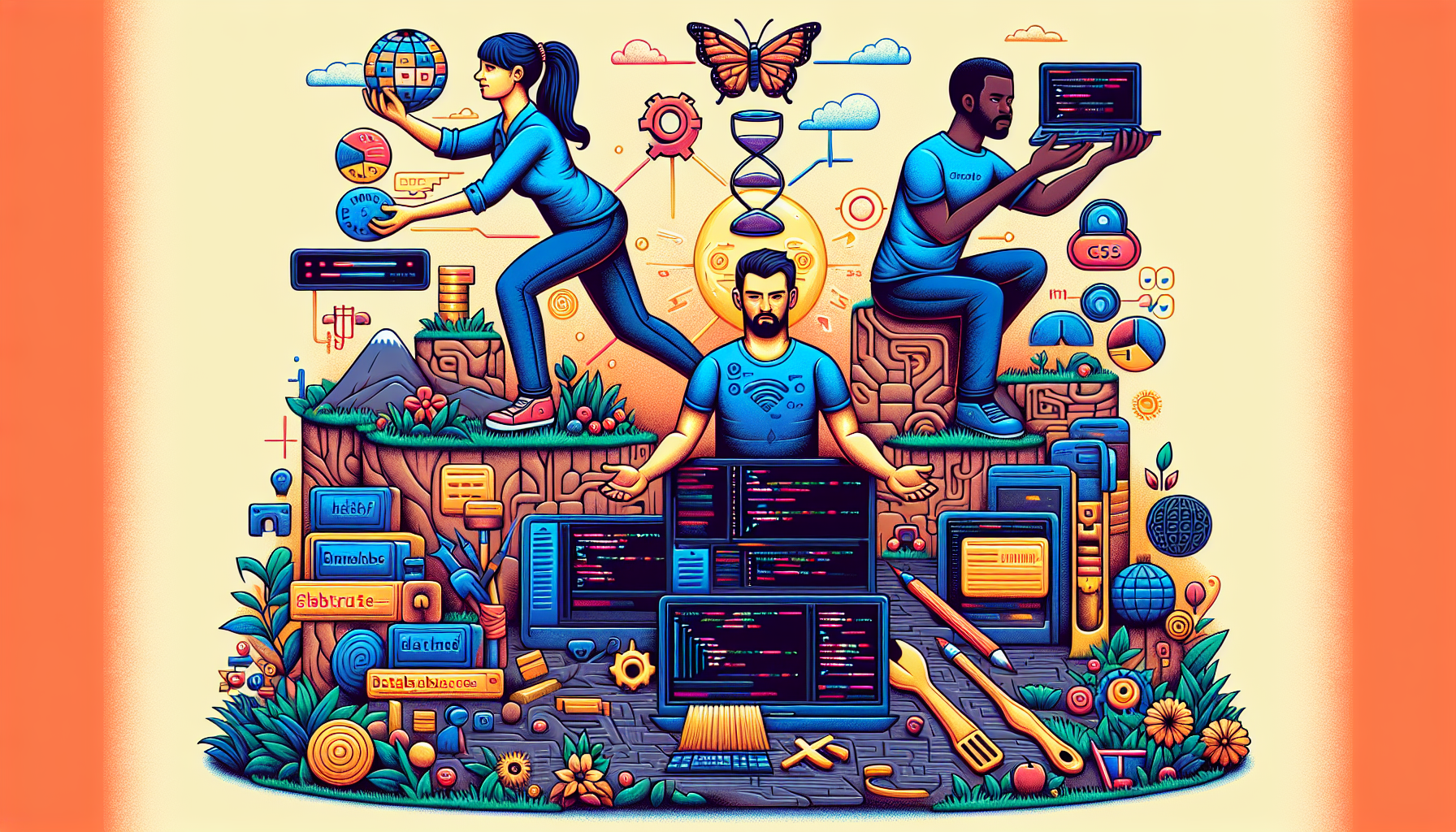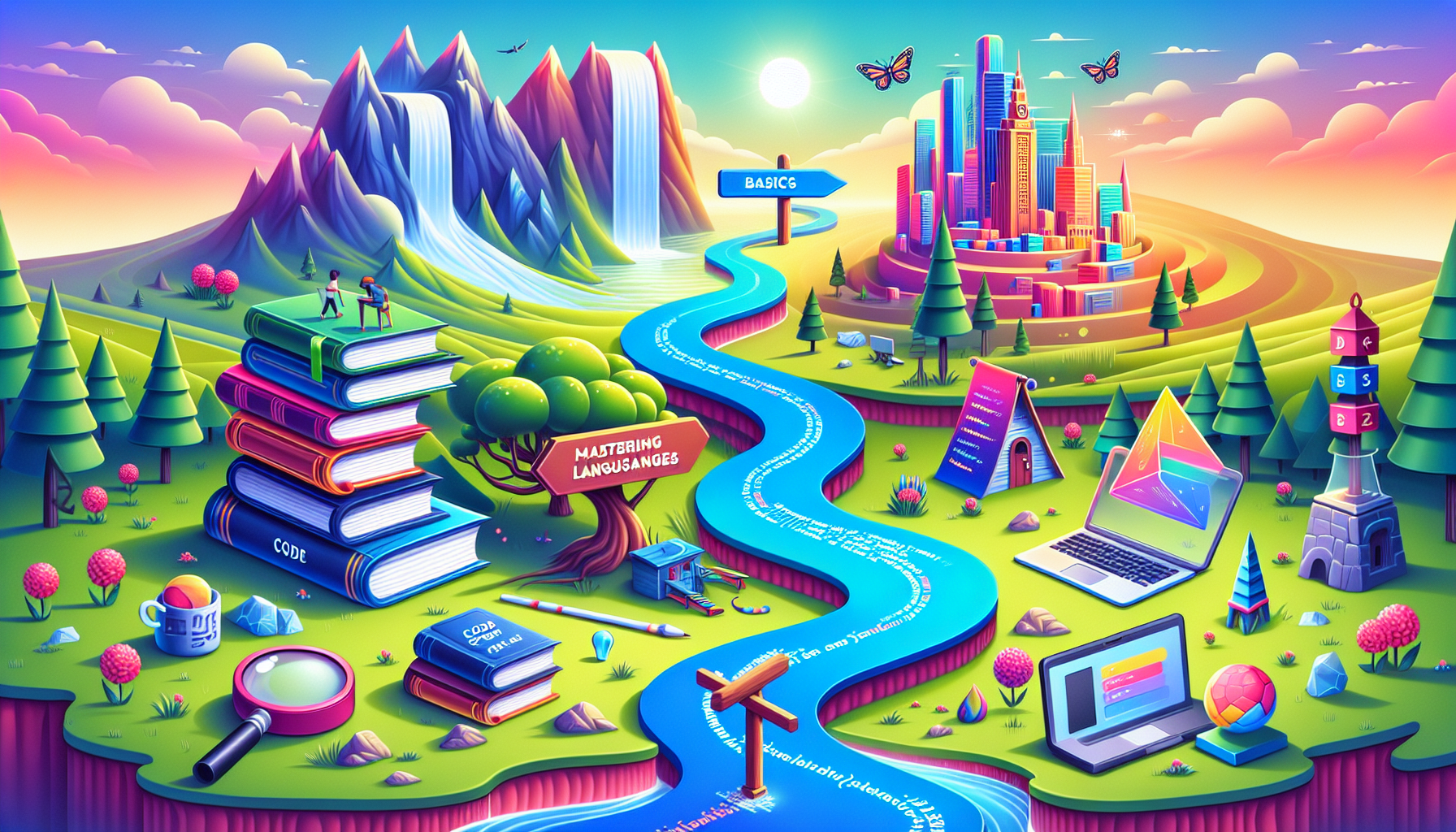At 31 years old, my favorite time is play with my daughther and wife, they are everything for me, without my family I won’t have the motivation to generate my own blog of software engineering topics.
Your Complete Developer Roadmap: Charting the Path to Coding Success
Are you aiming to forge a career in web development? The ‘developer roadmap’ is your blueprint for success. Cut through the noise and focus on what truly matters; this guide leads you from mastering the basics to building a robust portfolio. In this article, you’ll discover the necessary steps for frontend, backend, or full stack development, alongside crucial resources and tips to expedite your progress.
Key Takeaways
-
Web development consists of frontend, backend, and full stack development, each with distinct skills such as HTML/CSS/JavaScript for frontend, server-side languages and databases for backend, and a combination of both for full stack development.
-
Essential skills for web developers extend beyond coding to include version control, package management, and responsive design, facilitating collaboration, project efficiency, and the creation of adaptable web experiences.
-
A developer’s roadmap involves mastering the basics of web development, exploring frameworks and libraries, and creating a portfolio to showcase skills, while staying informed on industry trends and overcoming common challenges like imposter syndrome and ‘tutorial hell’.
Understanding the Web Development Landscape

Web development fundamentally includes activities such as programming, testing, deploying, and maintaining websites and web apps, which are all key to creating and managing a successful online presence. It’s a broad field, but it can be broken down into three major realms: frontend, backend, and full stack development. Each of these realms has a unique set of responsibilities and requires a different skill set.
Frontend development deals with the aesthetics and interactions of a website, leveraging HTML, CSS, and JavaScript. The backend, on the other hand, is all about server communication, user authentication, and databases, typically using languages like Python and Node.js. Full stack development is an intriguing fusion of the two, marrying the disciplines of frontend and backend, and covering both client-side and server-side of applications. The choice between frontend, backend, and full stack often depends on one’s career path choice or project requirements.
Frontend Development
Frontend development focuses on the user’s interaction, bringing the magic of web design to life. HTML, CSS, and JavaScript are the building blocks of this realm, used to create the structure, style, and functionality of websites respectively. HTML outlines the structure of web pages, CSS adds styling and layout, and JavaScript provides interactivity and dynamic behavior to the web content.
However, modern frontend development extends beyond these three, necessitating proficiency in popular frameworks and libraries such as:
-
React
-
Angular
-
VueJS
-
Svelte
These frameworks and libraries are used to build complex, responsive, and scalable single page applications.
Utilities and frameworks like Bootstrap offer predefined styles and components that can be easily integrated into web projects, including static web pages, to speed up the development process and maintain consistency across designs. These css frameworks have become essential tools for modern web development.
Backend Development
While users interact with the frontend, the backend operates as the unseen engine that ensures smooth operation. Backend developers are typically expected to be proficient in programming languages such as Java, Python, and JavaScript. They also need to be familiar with frameworks such as Express for Node.js, Django for Python, and Ruby on Rails.
Backend development likewise includes the use of databases, which are generally categorized into relational (SQL) and non-relational (NoSQL) databases like MongoDB. The backend is responsible for storing and processing all the data safely, managing the logic and the database, creating APIs, and handling data requests and responses effectively. It’s also where web security comes into play, with practices such as implementing HTTPS and adhering to guidelines from organizations like The Open Web Application Security Project (OWASP) being vital for protecting backend environments.
Full Stack Development
Full stack development is like the Swiss Army knife of web development. A full stack developer manages both user interface and user experience, working with a mix of frontend and backend technologies. This role requires a comprehensive understanding of how both sides of the development spectrum interact with each other to build complete web applications.
Being a full stack developer means you’re a Jack (or Jill) of all trades. It requires continuous learning and adaptability, as you’ll need to stay updated with the latest technologies on both ends of the web development spectrum. It’s a challenging role, but the reward of being able to:
-
Create a complete web application from scratch
-
Work on both the front-end and back-end of a website
-
Handle databases and server-side programming
-
Collaborate with designers and other developers
is truly fulfilling.
Essential Skills for Aspiring Web Developers

Aspiring web developers need to master a set of essential skills, which go beyond just coding. These include understanding and using version control systems, working with package managers, and creating responsive designs.
Version Control Systems
In the world of web development, version control systems are your trusty time machine. They’re crucial for tracking changes in a project and managing version history. Git, an open-source version control system, is used for tracking changes and collaboratively managing code among multiple developers. Even for solo developers, version control systems are beneficial for maintaining a detailed history and facilitating changes even in small projects.
Version control systems support a variety of workflows, enabling teams to choose how they integrate branching and merging into their development processes, thus facilitating collaboration. They offer a long-term history of file changes, including details like the author and purpose, which is essential for analyzing bugs and maintaining older versions of software.
Package Managers
Just as a librarian is essential for managing books in a library, package managers are indispensable tools for managing software libraries and dependencies within a development project. Commonly used by developers, popular package managers like npm and yarn help to efficiently install, manage, and update software libraries. These tools make the process of software development much more streamlined and convenient..
Using a package manager allows developers to seamlessly integrate and maintain a wide variety of libraries, ensuring that projects are up-to-date and compatible with their dependencies. It’s like having a personal assistant who keeps track of all your libraries, making sure they’re organized and updated.
Databases
In the realm of databases, aspiring web developers must cultivate a deep understanding of database management systems (DBMS) and their applications. Mastery of SQL (Structured Query Language) is foundational for efficiently querying and managing relational databases. Familiarity with popular systems like MySQL, PostgreSQL, and SQL Server equips developers to work effectively with diverse datasets. Additionally, proficiency in NoSQL databases such as MongoDB expands developers' toolkit, enabling them to handle unstructured data and scale applications horizontally. Furthermore, adeptness in database design principles is paramount for creating robust and scalable database schemas. Skills in normalization techniques, entity-relationship diagrams (ERDs), and indexing strategies are instrumental in crafting efficient data models that cater to specific application requirements.
Moreover, developers should hone their abilities in data manipulation and optimization to ensure optimal database performance. Writing complex SQL queries for data retrieval, manipulation, and aggregation empowers developers to extract meaningful insights from large datasets efficiently. Furthermore, familiarity with stored procedures, triggers, and functions enables developers to automate tasks and enforce business rules within the database environment. Proficiency in database administration tasks, including backup and recovery, performance tuning, and security management, ensures the integrity and availability of critical data. Additionally, staying abreast of emerging trends in database technologies, such as cloud-based databases and in-memory databases, enables developers to leverage cutting-edge solutions to address evolving business needs. By mastering these essential skills, aspiring web developers can effectively harness the power of databases to build robust and scalable web applications.
Responsive Design
In the age of smartphones and tablets, responsive design has become a must-have skill for web developers. It’s all about creating websites that adapt to the device and screen size, providing a seamless user experience across different devices. A key feature of responsive websites is their ability to adapt content to fit various screen sizes, eliminating issues like oversized images or the need for excessive scrolling on mobile devices.
Responsive design not only improves the user experience but also leads to significant cost savings by:
-
eliminating the need for separate mobile websites
-
optimizing websites for mobile use
-
meeting the high expectations of users
-
potentially increasing conversions
Mobile optimization is a critical part of creating a responsive design.
Navigating the Developer Roadmap: Key Milestones and Learning Resources

Having covered the essentials, you’re now ready to embark on your journey to becoming a web developer. Having a clear roadmap is crucial, as it provides guidance through the myriad of technologies and concepts necessary for the profession. Aspiring developers can start learning immediately, working towards key milestones such as mastering the basics, delving into frameworks and libraries, and eventually building a portfolio.
Mastering the Basics
The first milestone on the web development roadmap is mastering the basics of web development. This involves having a solid understanding of HTML, CSS, and JavaScript. There are various learning resources available to help you master these basics.
Online platforms that provide interactive lessons for HTML, CSS, and JavaScript include:
-
Codecademy
-
W3Schools
-
FreeCodeCamp
-
Mozilla Developer Network
-
Khan Academy
These platforms cater to different skill levels and offer a variety of resources such as written and video tutorials, hands-on projects, detailed documentation, forums, and self-paced video tutorials and exercises. They also provide a community for collaborative learning, complementing the educational content.
Establishing a solid foundation in HTML, CSS, and JavaScript is vital for progressing in the web development field, as these are the core technologies used by web browsers to render content.
Delving into Frameworks and Libraries
With the basics under your belt, the next milestone on the developer roadmap is delving into frameworks and libraries. Frameworks and libraries serve as tools that can enhance efficiency and manageability in web development.
Frameworks like React can help you build complex web pages and user interfaces, while libraries provide pre-written code to carry out routine tasks. These tools can greatly speed up the development process and allow you to tackle more complex projects. They are a crucial part of a web developer’s toolkit, and gaining proficiency in their use is a significant step on your journey to becoming a web developer.
Building Your Portfolio
The final milestone on the developer roadmap is building your portfolio. This is your chance to show off all the skills you’ve learned and the projects you’ve completed.
Your portfolio should exhibit a wide array of work, emphasize your unique skills, and demonstrate your development process to showcase your problem-solving abilities. Demonstrating your skills through a personal portfolio or open-source contributions can enhance your confidence by validating your abilities to both yourself and others. It’s your opportunity to shine and show potential employers what you’re capable of.
Staying Ahead: Keeping Up with Industry Trends and New Technologies

The dynamic field of web development necessitates ongoing learning. Keeping abreast with emerging technologies and evolving best practices is imperative for your career progression and the excellence of your work.
Following Industry News and Blogs
Staying informed about industry news and trends is crucial for any web developer. This can be done by following blogs, podcasts, and newsletters that focus on web development.
Podcasts and YouTube channels offer a range of content from tutorials to tech news, making them a valuable learning resource. Some popular podcasts and YouTube channels for web development include:
-
Syntax
-
The Net Ninja
-
Traversy Media
-
Codecademy
-
FreeCodeCamp
Newsletters like React Status and Bytes provide curated news and trends specific to the web development industry. By subscribing to these resources, you can stay up-to-date with minimal time investment.
Participating in Developer Communities
Engaging in developer communities is also a beneficial way to stay ahead. These communities offer a platform for:
-
sharing knowledge
-
obtaining mentorship
-
gaining motivation
-
collaborating professionally
-
keeping members informed about the latest technologies
A supportive network within these communities offers emotional support to developers, enhancing confidence and cultivating a sense of belonging. Contributing to open-source projects is another great way to learn new advancements in web development and network with peers. Supportive communities, like friendly Discord channels, provide environments for engaging conversations and support.
Overcoming Common Challenges for Web Developers

Despite being rewarding, the journey to becoming a web developer comes with its own set of challenges. These can include imposter syndrome, getting stuck in ‘tutorial hell’, and balancing work-life commitments. But don’t worry - we’ve got strategies to overcome these common challenges.
Imposter Syndrome
Imposter syndrome, a common psychological phenomenon causing individuals to question their accomplishments and fear being exposed as a ‘fraud’, can hinder developers’ progress. Overcoming imposter syndrome involves understanding that it’s a common experience among professionals and learning to value one’s own expertise and accomplishments.
Strategies to combat imposter syndrome include:
-
Expanding your skill sets
-
Avoiding negative comparisons
-
Seeking mentorship
-
Embracing a growth mindset to view challenges as opportunities
-
Acknowledging your achievements
-
Seeking realistic feedback
-
Understanding that mistakes are part of the learning process
These strategies can help you overcome imposter syndrome and gain confidence in your abilities.
Tutorial Hell
‘Tutorial hell’ refers to a situation where developers get caught in a never-ending cycle of following tutorials without applying the acquired knowledge to real-world issues. The key to escaping tutorial hell is to focus on building practical projects and applying what you’ve learned.
Implementing the concepts and techniques learned from tutorials into actual projects helps solidify your understanding and builds confidence in your abilities as a web developer. This not only reinforces your learning but also gives you practical experience, which is vital in the real world of web development.
Balancing Work-Life Commitments
Maintaining a healthy balance between work and personal life presents another challenge for many web developers, especially in the realm of project management. Balancing work and life commitments is crucial to prevent burnout and maintain long-term productivity.
Setting clear boundaries between work and personal time can help manage responsibilities effectively. Prioritizing tasks allows you to focus on high-impact activities, while ensuring time is reserved for personal life. Taking regular breaks is also essential to recharge and avoid the negative effects of prolonged work without rest.
Summary
Navigating the world of web development can seem daunting, but with a clear roadmap and the right resources, it becomes a rewarding journey of continuous learning. By mastering the basics, delving into frameworks and libraries, building a portfolio, staying updated with industry trends, and overcoming common challenges, you can chart a successful path in the dynamic field of web development. Remember, it’s not a sprint but a marathon, so keep learning, keep coding, and most importantly, enjoy the journey!
Frequently Asked Questions
What are the basic skills required for web development?
To work in web development, you'll need skills in HTML, CSS, JavaScript, version control systems, package managers, databases, system design and responsive design for different devices. These are the basic skills essential for web development.
What is the difference between frontend and backend development?
Frontend development focuses on website aesthetics and interactions using HTML, CSS, and JavaScript, while backend development manages server communication, user authentication, and databases with languages like Python and Node.js.
What is full stack development?
Full stack development involves both frontend and backend development, allowing a developer to manage user interface and user experience using a variety of technologies.
How can I stay updated with the latest trends in web development?
To stay updated with the latest trends in web development, consider following industry news, subscribing to newsletters, participating in developer communities, and continuously exploring new technologies.
How can I overcome common challenges such as imposter syndrome and tutorial hell in web development?
To overcome imposter syndrome in web development, acknowledge your accomplishments, seek realistic feedback, and understand that mistakes are part of the learning process. To escape tutorial hell, focus on building practical projects and applying what you've learned to gain experience and confidence.